|
Hilda Tresz
Global Volunteer Work
|
|
|
|
Chengdu Zoo |
|
February 15-19, 2014
Goals
To
provide information regarding exhibit improvements, zoo-wide
animal training, basic husbandry and enrichment and to hold
educational workshops
Chimpanzees
(Pan troglodytes ?) Subspecies unknown
Suggestions:
Subspecies needs to be determined by DNA testing.
|
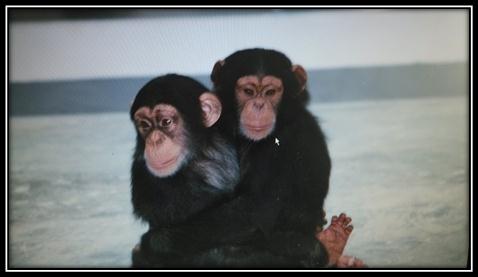 |
|
Female
乖乖
(Guai
guai) was born in Beijing on 26 January 2006; male 宝宝
(Bao
bao) was born in Beijing on 9 January 2006. They were
transferred to Chengdu on 20 September 2007.
|
|
|
|
Chimpanzee
Exhibit
The
chimpanzee exhibit was satisfactory in size with natural
soil and plenty of climbing structures. The night house was
large enough, made of concrete and metal. I was most happy
to find the chimpanzees on substrate when kept inside. The
animals were locked inside during the wintertime.
|
|
 |
 |
|
|
|
Suggestions:
To
further improve quality, permanent furniture needs to be
installed, especially sleeping nests. The nests should be
installed as high as possible both in
the
on-
and off-exhibit
areas. Please review example pictures below.
 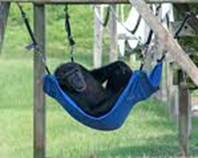 
Metal
basket, hammock and platform for sleeping furniture both
inside and outside
|
|
.
| |
|
The night
houses could utilize three dimensions by adding large
tree trunks, ropes, fire hoses, hammocks, wooden
shelves, etc to increase space and allow opportunities
for exercise, exploration and manipulation |
| |
|
Boomer
ball products are not so easy to come by in China, but
recycled household products (cereal boxes, ardboard boxes,
plastic bottles, barrels, plastic cups, old plush toys,
towels, clothing, tires, etc.) can be easily incorporated as
enrichment/toys.
|
| |
|
It
would be preferable to add more windows or skylights to
increase light. It would also be advantageous to build double
sliding doors (one being solid and the other one built
from bars and mesh) such that the night houses and the
exhibit could be connected with a “Round Robin”
system, allowing animals to move about in circular ways
and not just a linear fashion. This system could be used for
all other species as well and would help with introductions
or with shifting animals more easily and quickly.
|
| |
|
Chimpanzees
can be allowed outside for limited time during the winter;
however, they need to have access to inside heat and be
provided with extra blankets. Some institutions keep to a
temperature guideline and will only let their chimpanzees
out if the temperature reaches 10-13 C, while others, such
as Chimpanzee Sanctuary Northwest, USA, allow the
chimpanzees to make their own decision. It is important,
however, that chimpanzees truly have a choice to seek warmth
if allowed outdoor access during cold weather. And there
might be a temperature so low that outdoor access is
inappropriate.Generally though,
the only time these institutions don't allow chimpanzees
outside is when heavy, wet snow reduces the voltage on their
electric fences.
|
|
Chimpanzees
in Snow: Google
Search |
|
|
| |
 |
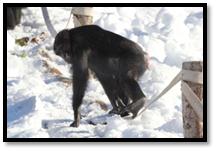 |
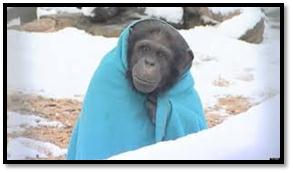 |
|
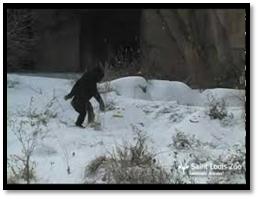 |
|
Wales Ape and Monkey Sanctuary, U.K
|
Snow
day for the chimpanzees at Saint Louis Zoo: YouTube
|
Saint Louis Zoo, USA
|
| |
|
|
|
General
Propositions:
|
|
|
|
Night
Houses, Off-Exhibit Areas and Correct Substrate Use
Many
animals (mostly carnivores and primates) were kept on
sterile surfaces with
reduced chance for exploratory behaviours. This
practice likely originated out of good intent to keep a
clean environment for the animals, as it appears to be a
cultural inheritance that if an exhibit is not hosed
frequently, than the animals are not being well cared for.
However, this practice creates poor conditions for the
animals.
The
problem was most prominent at the Children’s Zoo area,
where small lambs were shivering on ice-cold, wet concrete
in the middle of winter. Farm animals were covered with a
mixture of water, urine and fecal matter up to their knees
with no way of drying off or warming up.
|
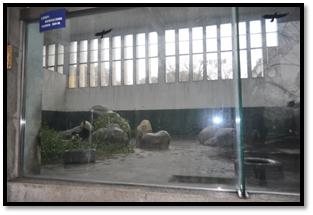 |
 |
 |
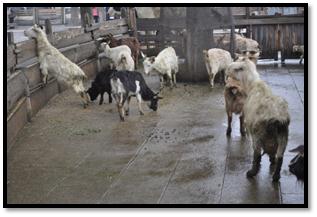 |
 |
 |
| |
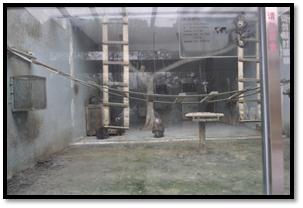 |
|
|
Suggestions:
|
| |
|
Begin
keeping animals off unyielding surfaces (brick, concrete,
etc.),especially species that have sicknesses (Rhesus
macaques with fur problems). The use of appropriate
substrate (inside- paper products, hay or straw, etc.;
outside- nonflammable materials such as grass, sand, soil,
mulch, fresh browse, etc.) will make a significant
difference not only in the animals’ mental and physical
health, but also in improvement of the exhibit aesthetics.
Using substrate will also reduce cleaning time and water
consumption. Soaking, scrubbing and hosing dry waste takes
much longer than spot cleaning due to substrate absorbing
urine and covering feces. Reducing hosing and partially
covering surfaces with substrate will overcome any of these
obstacles and provide animals with a soft surface.
|
| |
|
Solitary
Primates
|
| |
|
Several
primate species were kept on bare concrete and also in
solitary confinement without any visual or tactile
opportunities with other primates.
Social isolation and reduced space allowance have been
documented to cause increased levels of aggression and
stress levels in a range of captive wild animals from
primates to dolphins.
|
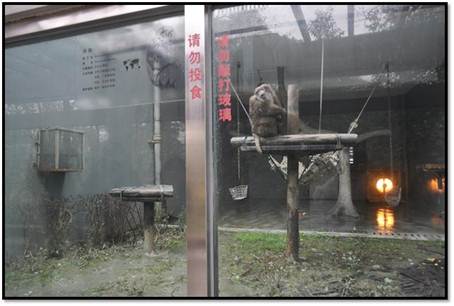 |
| |
|
Suggestions:
|
| |
|
Solitary
primates need to be able to see, smell and touch other
primates, even if it is a different species, until they are
paired up with their conspecific. Please review laws and
guidelines regarding social keeping of primates:
|
| |
|
Title 9, Code of Federal Regulations, Subchapter A – Animal
Welfare Part 3 Standards, Subpart D Specifications for the
Humane Handling, Care, Treatment, and Transportation of
Nonhuman Primates, Section 3.81
Sec. 3.81 Environment enhancement to promote psychological
well-being.
Dealers, exhibitors, and research facilities must develop,
document, and follow an appropriate plan for environment
enhancement adequate to promote the psychological well-being
of nonhuman primates. The plan must be in accordance with
the currently accepted professional standards as cited in
appropriate professional journals or reference guides, and
as directed by the attending veterinarian. This plan must be
made available to APHIS upon request, and, in the case of
research facilities, to officials of any pertinent funding
agency. The plan, at a minimum, must address each of the
following:
|
|
(a) Social grouping. The
environment enhancement plan must include specific
provisions to address the social needs of nonhuman primates
of species known to exist in social groups in nature.
Individually housed nonhuman primates must be
able to see and hear nonhuman primates of their own or
compatible species unless the attending veterinarian
determines that it would endanger their health, safety, or
well-being.
|
|
Canadian Council on Animal Care,
Olfert ED, Cross BM, McWilliam AA 1993.
Guide to the Care and Use of Experimental Animals, Volume 1,
2nd Edition. Canadian Council on Animal Care, Ottawa
"The social needs of animals used in research,
teaching, or testing, should be given equal consideration
with environmental factors such as lighting, heating,
ventilations and containment (caging). Particularly in the
case of singly housed animals, daily observation provides an
alternative from of social contact for the animal and
commonly facilitates handling in that the animal becomes
accustomed to the human presence. .. Most animals should not be housed singly unless required by medical
condition, aggression, or dictates of the study. Singly
housed animals should have some degree of social contact
with others of their own kind. ... In the interest of
well-being, a social environment is desired for each animal
which will allow basic social contacts and positive social
relationships. Social behaviour assists animals to cope with
circumstances of confinement."
European Commission 2002.The
Welfare of Non-human Primates - Report of the Scientific
Committe on Animal Health and Animal Welfare. European Commission, Strasbourg, France
http://europa.eu.int/comm/food/fs/sc/scah/out83_en.pdf
"Primates should not be
housed singly unless fully justified by health
considerations (for the animal and human handler) or
research procedures, as advised following an ethical review
process. If primates have to be singly housed, the animals
should have visual, olfactory and autitory contact with
conspecifics.”
International Primatological Society 1993.
IPS International guidelines for the acquisition, care and
breeding of nonhuman primates, Codes of Practice 1-3.
Primate Report 35, 3-29
" A compatible conspecific probably provides more
appropriate stimulation to a captive primate than any other
potential environmental enrichment factor. ... Monkeys
should, unless there are compelling reasons for not doing
so, be housed socially. ... Young monkey should not
normally be separated from its mother at an early age (i.e.,
at 3-6 months) but should remain in contact for one year to
18 months, in most species. There is unlikely to be any
greater productivity through early weaning, in seasonally
breeding species, such as rhesus monkeys. Even in
non-seasonal breeders, any slight increase in productivity
must be offset against the resulting behavioural
abnormalities of the offspring."
National Research Council 1996.
Guide for the Care and Use of Laboratory Animals,
7th Edition. National Academy Press, Washington
"Animals should be housed with the goal of
maximizing species-specific behaviors and minimizing
stress-induced behaviors.
For social species, this normally requires housing in
compatible pairs or groups."
National Research Council 1998.
The
Psychological Well-Being of Nonhuman Primates.
National Academy Press, Washington
"Social interactions are considered to be one of the
most important factors influencing the psychological
well-being of most nonhuman primates. ... The common
practice of housing rhesus monkeys singly calls for special
attention [p. 99] ... Every
effort should be made to house these [singly caged] animals
socially (in groups or pairs), but when this is not
possible, the need for single housing should be documented
by investigators and approved by the IACUC. ... The animal
technician's and caregiver's roles are pivotal to the social
support of primates, particularly animals that are singly
caged."
|
|
Immediate improvements:
·
At
the Carnivore area, a keeper started to make immediate
changes and the animals showed instant positive response.
·
At
the Primate area a single housed male squirrel monkey was
immediately introduced to two other squirrel monkeys.
·
Farm
area staff refused any collaboration with the consultant.
|
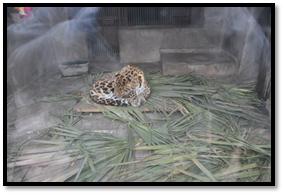 |
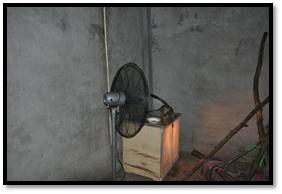 |
| |
|
Browse
The
zoo has a large amount of edible vegetation available on
grounds that can provide fresh, leafy branches (browse).
Suggestions:
Browse
should be provided at least every 2-3 days, but if possible,
every day for animals that need it. The zoo can plant edible
trees, bushes and even crops inside and outside of exhibits,
along visitor pathways and resting areas that will provide
future browsing materials for growing collection demands.
Whether cut by staff or available by natural damage, fallen
vegetation can be used rather than wasted.
Correct
Furniture
|
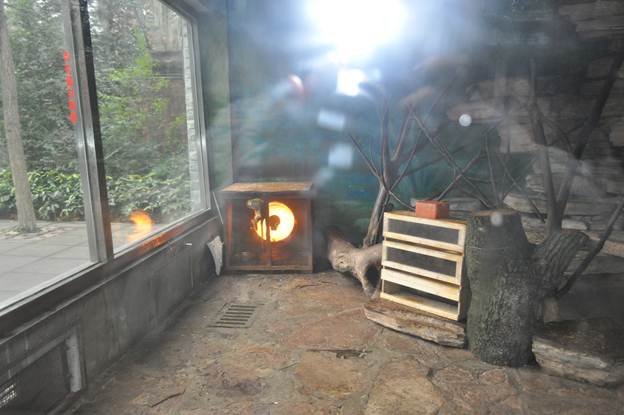 |
| |
|
Suggestions:
During
the winter, animals (especially tropical animals) need to
spend large amounts of time in front of heating units.
Resting areas (platforms, baskets, etc.) in front of the
heating units are preferred. They are more comfortable for
the animals and less of a safety and burn hazard. Heating
units should be elevated to higher parts of exhibits for
arboreal animals, such as squirrel monkeys.
Mixed
Species Exhibits
Mixed
species exhibits can be created in order to free up space
and develop a more esthetic, complex exhibition. This type
of exhibit also resolves certain problems associated with
housing otherwise social species alone until they are paired
paired with a conspecific. Please review the photos of
Phoenix Zoo mixed exhibits.
|
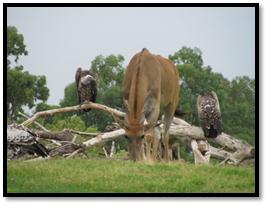 |
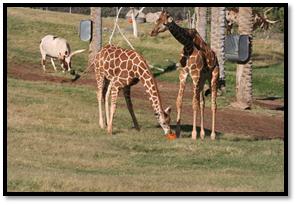 |
| |
|
Pet
Trade
Outside
vendors selling pets at the front gate should not be
encouraged. These animals are kept in substandard
circumstances such as small, sterile cages without shelter
from the elements (fish in Ping-Pong ball size containers,
guinea pigs freezing during winter without substrate, etc.).
Chengdu Zoo, as one of the top four zoos in China, did a
great job on animal conservation and education, while such
vendors just send wrong message to visitors and could easily
hurt Chengdu Zoo’s reputation.
|
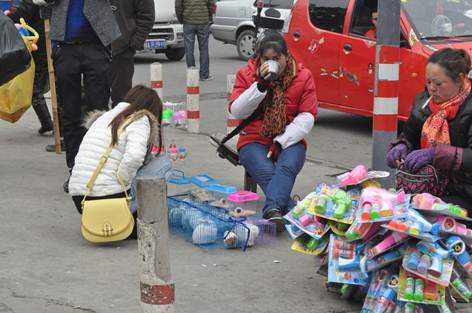 |
| |
|
Extending
Foraging Time
Suggestions:
All
animals need to be fed in a way that their foraging time is
extended and proper species-specific behaviors are
encouraged. If no one can be appointed for this position,
staff can be scheduled to cut browse and chop diet on a
rotation basis.
Smoking
Keepers
were often observed smoking, some of them inside the night
house right next to the animals.
Suggestions:
The
zoo should change its smoking policy by creating designated
smoking areas for visitors with tables, chairs, ashtrays
and garbage cans. All visitors that want to smoke should be
directed to these areas. In addition, keepers should no
longer smoke in front of visitors and absolutely should not
smoke inside the animals' night houses and/or next to the
animals. Keepers must also have designated smoking areas
behind the scenes, out of visitor view. Keepers should only
smoke during their breaks.
|
|
Education
The
following PowerPoint presentations were given to all staff:
·
Lack of Substrate Use in Zoos
addresses
the easy fix of empty cages and shows how much benefit there
is in the animals’ lives when provided with substrate
(i.e., when they do not have to sit inside of empty,
concrete cages). This is probably the most important animal
welfare presentation to give out of the five.
·
Contra Freeloading at the Phoenix Zoo
talks about extending foraging times by making animals work
for their food in ways similar to their wild counterparts,
instead of eating diet in short periods of time from
provided dishes.
·
The Beneficial Browse
presentation
provides guidelines on how to develop a low cost, zoo-wide
browse program in the middle of the Sonoran Desert. It also
addresses the major changes that fresh, leafy greens can
make in the animals’ lives.
·
Let Them Be Elephants addresses the
changes the Phoenix Zoo made in our elephants’ lives, how
we helped their behaviors by teaching them how to correctly
forage and behave like normal females. It also talks about
basic husbandry, enrichment ideas and health care.
Presentations
are available at
htresz@thephxzoo.com.
I
would like to thank the Chengdu Zoo’s director and staff,
as well as the
Chinese Association of Zoological Gardens (CAZG),
for
their incredible hospitality — making me feel so welcomed.
I
would also like to thank Animals Asia Foundation for funding
and organizing this trip and to establish such a wonderful,
working relationship between the Jane Goodall Institute, the
Phoenix Zoo and the Chengdu Zoo.
|
|
References:
Harris,S.
& Lossa, G & Soulsbury, S.D. A review of the welfare
of wild animals in circuses
School of Biological Sciences, Woodland Rd, University of Bristol,
Bristol, BS8 1UG http://www.rspca.org.uk/ImageLocator/LocateAsset?asset=document&assetId=1232714755621&mode=prd
Hemsworth, P.H. & Barnett, J.L. (2000) Human-animal
interactions and animal stress. In: The biology of animal
stress (eds. Moberg, G.P. & Mench, J.A.), pp. 309-335.
CABI.Publishing, Oxon, UK
Morgan,
K.N. & Tromborg, C.T. (2006) Sources of
stress in captivity. Applied Animal Behaviour Science doi:
10.1016/j.applanim.2006.05.032
Moberg,
G.P. (2000) Biological response to stress:
implications for animal welfare. In: The biology of animal
stress (eds. Moberg, G.P. & Mench, J.A.), pp. 1-21. CABI.
Publishing, Oxon, UK
Tresz,H.
(2011). The lack of substrate use in zoos, ICEE.
CNN Wire Staff (2011). Animal performance ban looms in
China
Morgan,
K.N. & Tromborg, C.T. (2006) Sources of
stress in captivity. Applied Animal Behaviour Science
10.1016/j.applanim.2006.05.032http://www.reed.edu/biology/professors/srenn/pages/teaching/2008_syllabus/2008_readings/1_MorganTromborg2008.pdf
|
|
|
|
Contact Information
ChimpanZoo
the Jane Goodall Institute
| Global
BWB Secretarial Limited
10 Queen Street Place
London, EC4R 1BE
United Kingdom
ChimpanZoo Webmaster |
























